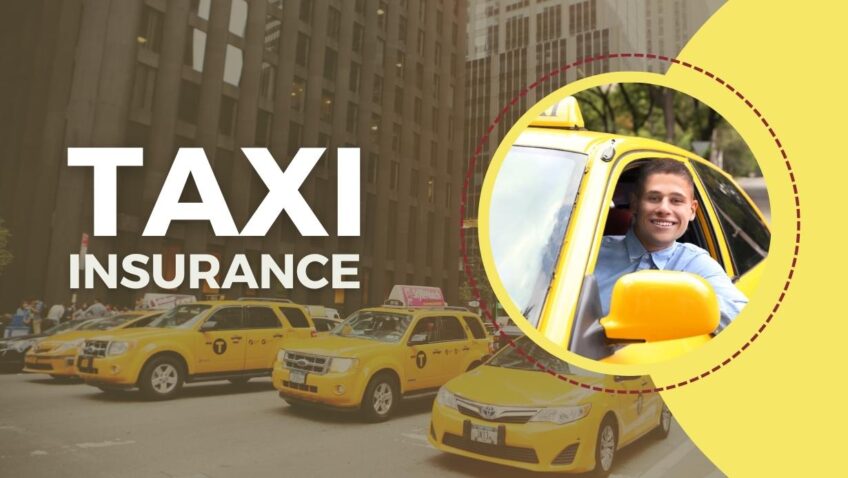If you’re in the taxi business and planning to drive passengers around, obtaining a taxi insurance policy is a crucial step. While there is no set standard for what taxi insurance costs, understanding the range of possible prices can help plan your budget and find an appropriate policy for you.
Depending on your different needs and what type of coverage you want to purchase, taxi insurance prices can vary and depend on several factors such as the geographic location in which you operate, the amount of coverage, and discounts. Furthermore, it’s important to understand how taxis are insured differently from private vehicles when comparing prices for both types of insurance policies.
In this article, we will cover how much taxi insurance costs and some key factors that go into determining how much your policy will cost.
Factors Affecting Taxi Insurance Cost

When it comes to calculating taxi insurance costs, there are a variety of factors that can affect the price. These factors can include the type of vehicle you are insuring, the area in which you operate, the number of passengers, and other individual factors.
Let’s explore these factors in more detail and see what effects they have on taxi insurance costs.
Vehicle Type
These policies are largely based on the size, weight, and engine power of the car or van. In addition, insurers consider whether cars used for passenger transportation have extra components such as radios or partitioning — these will have an effect on the cost of taxi insurance.
When choosing a taxi for passenger transportation, look for one with safety features like airbags and ABS (anti-lock braking system). These can potentially affect your premium rate as many insurers include them in their calculations. Additionally, some premiums also take into account whether your car has features that limit environmental emissions.
Overall, there is no standard price for taxi insurance — it depends on a variety of factors, including vehicle type. For instance, small city cars are likely to be cheaper to insure than larger vehicles like minibusses or MPVs due to their smaller size and weight meaning they’ll be less expensive to repair if they’re involved in an accident. Make sure you research different vehicle types thoroughly before selecting a car or van as this could make all the difference when you’re looking at insurance policies and quotes.
Location

Location plays an important factor when considering the cost of it. Insurance premiums in densely populated urban areas are generally more costly due to the higher risks associated with cities, such as more cyclists and pedestrians, higher chances of accidents, and more difficult parking situations. Insurance in rural areas usually costs less because the number of potential risks is lower.
Rates also vary greatly among states and within local areas due to varying levels of regulation and competition. Knowing where you operate is important for getting an accurate estimate of your taxi insurance cost.
Other factors to consider include the age and size of your taxi, additional coverage types you’re interested in adding, such as on-demand rides or ride-sharing fares, any discounts available from providers or associations you belong to, and any activities your drivers may be participating in that could affect their risk profile (such as carrying passengers regularly across state lines). Additionally, deductible amounts can have a dramatic effect on your overall premium — higher deductibles typically mean lower premiums but provide less coverage in an accident situation.
Driving Record
The first factor that insurers consider when assessing insurance premiums is the driver’s driving record. The insurer will take into account any previous traffic offenses, such as speeding tickets, DUIs, citations for reckless driving, and other similar violations. In general, the more serious the offense and the more recent in which it has occurred, the higher the risk to insure a driver.
Drivers with a clean record or only minor infractions on their record are likely to receive lower premiums than drivers with a history of significant violations. Additionally, frequency of driving can also play into this category – if you have more distance driven in a given time period, insurers may increase your cost to cover the additional risk.
Age of Driver

Age plays an important role in determining how much your insurance will cost. As expected, the younger you are and the less experience you have, the higher your insurance premiums could be. Insurance companies consider drivers in the age group of 18-25 years to be particularly risky and this age group may see a significant increase in their insurance costs.
In addition to your actual age, some insurers also take into account how long you have been driving when assessing your risk level. If you have recently passed your driving test and you’re still a relatively inexperienced driver, expect to pay more for cover than someone who has been on the roads for many years. It is worth noting that even if you’re an experienced taxi driver who is over 25 years of age, this won’t guarantee low premiums – it just puts you on a more level playing field with other drivers.
You can sometimes get discounts by taking additional courses or working with an approved mentor but these eligibility requirements vary from insurer to insurer so it’s best to contact each one individually before making a decision.
Type of Coverage
The cost of taxi insurance depends on numerous factors, including the type of coverage purchased. Depending on the coverage that is selected, taxi drivers could purchase insurance policies tailored to their needs or opt for standard packages offered by insurers.
Policies may offer coverage for both when the taxi is being used for fares as well as when it’s not. This includes Public Liability Insurance, which protects drivers if they cause injury or property damage while working, Collision Coverage, and Property Damage Coverage to cover damage to your vehicle resulting from a collision with another car, theft, and other perils. Comprehensive coverage options can be added at an additional cost and may include cover against fire and malicious damage, weather-related damage such as floods and hurricanes, vandalism, broken glass claims, and more. Other specialized policies may also be available depending on the insurer.
It’s also important to understand any applicable policy requirements related to mileage limits as well as restrictions on driving certain types of vehicles or routes. In addition to determining the type of coverage desired, drivers must consider where their vehicle is garaged in order to get an accurate estimate of costs associated with taxi insurance premiums.
Average Cost of Taxi Insurance

It is a necessary expense for taxi companies, private hire vehicles, and taxi drivers. The average cost of taxi insurance depends on a variety of factors, such as the size of your fleet, the type of vehicle you drive, and the state you operate in.
Let’s take a look at the average cost of taxi insurance, and some strategies you can use to lower your premiums.
Liability Coverage
Taxi drivers and their vehicles must be properly insured to provide rides, and liability coverage is typically the most important form of insurance offered. Liability coverage protects a driver from being sued and paying out-of-pocket expenses in case they are responsible for an injury or property damage.
This coverage includes bodily injury protection, property damage protection, uninsured or underinsured motorist bodily injury protection, and personal injury protection. State minimums vary on these types of coverage, but taxi insurance costs typically range from $500 – $1500 per 6 months depending on your state, the factors of your business, the type of vehicle insured, limits, and deductible set.
Collision Coverage
Collision coverage is a type of insurance that can cover the cost of physical damage caused to your vehicle in the event of an accident, regardless of fault. This includes repair costs for body damage and any damage done to other vehicles involved in the accident. Collision coverage is often an optional addition to basic policies for taxi vehicles, providing additional peace of mind for operators in case an emergency occurs.
The cost of collision coverage depends on a variety of factors specific to the taxi driver, including age and driving record as well as other factors such as access to high-risk or special insurance pools or whether you qualify for discounts based on your driving record or years through a single provider.
Generally, collision coverage costs between $100 and $300 per month; however, this may vary significantly depending on the specifics of your policy. Speak with an experienced insurance broker who will understand your specific circumstances in order to get an accurate estimation of what kind of cost you should be expecting.
Additionally, there may be other restrictions or qualifications associated with including this type of coverage with your policy. Consulting with an experienced agent is always recommended when making decisions regarding purchasing insurance policies or adding additional riders and riders.
Comprehensive Coverage
Comprehensive coverage is the broadest type of taxi insurance and includes things like damage from an accident, theft, and vandalism, as well as damage from natural disasters. Comprehensive insurance coverage typically also covers you in the event of an uninsured motorist or hit-and-run driver. Depending on the company and your specific needs, comprehensive coverage can include a variety of riders including liability, medical payments, and other types of coverage.
The cost of it varies depending on the type of usage. For example, those who use their vehicle to transport passengers would likely need a more comprehensive policy than someone who just uses it occasionally for errands around town. The price can also vary significantly depending on whether you opt for basic coverage or add riders to customize your plan more specifically to your needs. Ultimately, comprehensive taxi insurance will typically run several hundred dollars per year if you only own one vehicle; however, if you own multiple vehicles used for transportation services then insuring them all will come at an additional expense.
Tips to Lower Your Taxi Insurance Cost
This is an important investment for any taxi cab service. It protects from a range of potential risks, including damage to vehicles, property, and employees. While taxi insurance can be expensive, there are a few ways to reduce the cost.
Bundle Your Policies
By combining a number of insurance policies into one, you can save money on your coverage. Different insurance carriers use different formulas for determining rates but, in general, the more policies you can bundle together the more money you may be able to save.
You might consider bundling your taxi insurance with other forms of commercial vehicle coverage, such as delivery vans and other business vehicles. If you’re eligible, Bundling your personal policies (such as home and auto) could result in additional savings as well. This is an easy way to reduce costs while covering a variety of needs.
Be sure to shop around first and compare policy terms and pricing before making any final decisions. While potentially saving money is always nice, you shouldn’t prioritize cost over quality coverage or lower service levels – make sure you’re still getting the best value for your money.
Raise Your Deductible
Raising your insurance deductible is one of the best ways to save money on taxi insurance. Your deductible is the amount you are responsible for paying if you have an accident. Therefore, the higher your deductible, the less you will pay in insurance premiums each month. For example, raising your deductible from $500 to $1,000 can typically save you between 10 and 25 percent on your taxi insurance cost.
It’s important to make sure that you have enough money set aside in case of an accident since you will need to be able to pay the full deductible amount before your policy kicks in and covers the rest. A good rule of thumb is to always keep double or triple what you should need for a claim available in savings. Doing this helps ensure that, if a claim does come up, there won’t be any financial hardship due to not having enough for your deductible when it’s time to pay it off.
Compare Rates
Shopping around for your taxi insurance rates is an important step in finding affordably priced coverage. Make sure you compare quotes from different companies and agencies before deciding on a policy. Be sure to take into account the deductible information, types of coverage offered, discounts available, customer service experiences, and overall price of the policy when you are making your comparisons.
It’s important to consider all the features within each quote so that you don’t miss out on any kind of savings or discounts. Speak with an agent who is familiar with taxi-specific policies so that they can help advise which one best fits your needs and budget. Additionally, be sure to talk to people who either make use of taxi services or own a taxi business as they may provide helpful insights on reliable insurers and pricing models. Knowing more about what other providers offer may help you uncover beneficial bargains that provide excellent insurance protection at reasonable costs.
FAQs

Can I add additional drivers to my taxi insurance policy?
Yes, many of them allow for additional drivers to be added to the policy, although this may result in higher premiums.
What happens if I don’t have insurance and get into an accident while driving a taxi?
If you don’t have it and get into an accident while driving a taxi, you may be held liable for any damages or injuries that result from the accident. This can result in significant financial penalties and legal consequences.
How can I save money on my taxi insurance premiums?
There are several ways to save money on it, including shopping around for the best rates, choosing a higher deductible, and maintaining a good driving record.
Can I cancel my taxi insurance policy at any time?
Yes, most of them allow for cancellation at any time, although there may be fees or penalties associated with canceling before the end of the policy term.
Can I choose the level of coverage for my taxi insurance policy?
Yes, most of them allow for a range of coverage options, including liability coverage, collision coverage, and comprehensive coverage.
Conclusion
In conclusion, these costs can vary greatly depending on a variety of factors. The type of coverage you need and the age, experience, and driving record of the driver will all have an impact on the premium you pay. In most cases, commercial policies are more expensive than those for private vehicles due to additional risks associated with operating a taxi service.
With insurance premiums on the rise, it’s important to shop around for the best rate possible by comparing quotes from several providers before deciding to purchase a policy.

